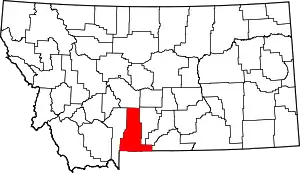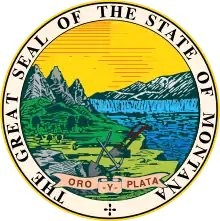Livingston, Montana
Livingston is the county seat of Park County, Montana, United States.[4] It is in southwestern Montana, on the Yellowstone River, north of Yellowstone National Park. Its population was 7,044 at the 2010 census.
Livingston | |
|---|---|
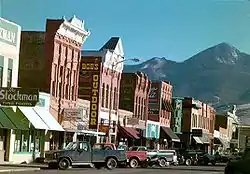 Downtown Livingston | |
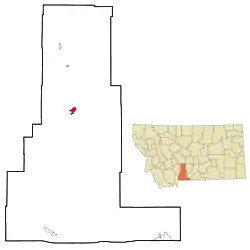 Location of Livingston, Montana | |
| Coordinates: 45°39′32″N 110°33′49″W | |
| Country | United States |
| County | Park |
| Area | |
| • Total | 5.70 sq mi (14.75 km2) |
| • Land | 5.64 sq mi (14.61 km2) |
| • Water | 0.05 sq mi (0.14 km2) |
| Elevation | 4,501 ft (1,372 m) |
| Population | |
| • Total | 7,044 |
| • Estimate (2019)[3] | 7,801 |
| • Density | 1,382.91/sq mi (533.95/km2) |
| Time zone | UTC−7 (Mountain (MST)) |
| • Summer (DST) | UTC−6 (MDT) |
| ZIP code | 59047 |
| Area code(s) | 406 Exchanges: 222,823 |
| FIPS code | 30-43975 |
| GNIS feature ID | 0773511 |
| Website | www |
History
The founding of the small historical railroad and ranching town of Livingston is a direct result of the Northern Pacific Railway. This site became a centralized point in the Rockies and the NPR's location for railroad shops to service NPR steam trains before their ascent of the Bozeman Pass, the line's highest point. Livingston also became the first gateway town to America's first national park, Yellowstone, which the NPR promoted heavily to visitors from the East. The NPR operated a branch line running 50 miles south through Paradise Valley, first to Cinnabar station and later to Gardiner, Montana.
Clark City
Downstream the Yellowstone River, about 3 miles from present-day Livingston, an old fisherman named Amos Benson built a log cabin in 1872. This is where a ferry, a trading post and a small community called Benson's Landing was. Across the river from Benson's Landing in June 1882 was the camp of about 40 tents of the Northern Pacific survey crew. This is where they thought the supply store site they were looking for should be. On July 14, 1882, a man who worked for the Northern Pacific named Joseph J. McBride arrived with orders to find another site to build the store. On July 16, George H. Carver, who became a major local businessman and political leader, arrived at the site of present-day Livingston. Carver and McBride became the first local residents when they pitched their tents on the 16th. Also on the 16th arrived 30 freight wagons drawn by 140 oxen, carrying 140,000 lbs. of merchandise. The supply store was to be of Bruns and Kruntz, contractors. Eventually the tents gave way to log cabins. All of Benson's Landing encampment moved up the river to Carver and McBride's camp within 10 days of the train's arrival.
This new settlement was called "Clark City" after Heman Clark, the principal contractor for the Northern Pacific from the Missouri westward. By fall the town was well established and a November 1882 poll counted 348 votes for delegates to congress. Clark City was on the southeast side at the East end of Lewis St. just southwest of the KPRK, and is now part of Livingston. B.F. Downen built the first permanent residence (out of wood) and Frank White owned the first saloon. Clark City eventually had 6 general stores, 2 hotels, 2 restaurants, 2 watchmakers, 2 wholesale liquor dealers, 2 meat markets, 3 blacksmiths, 1 hardware store, 30 saloons and a population of 500.
As Clark City was growing nobody realized that the Northern Pacific had marked on its maps a town called Livingston at the same place. The railroad officially reached Clark City on November 22, 1882. In October 1882 a post office was chartered for Clark City. In November, Livingston received its charter. That was when it was decided that Livingston be located a short distance away. Then Clark City residents bought lots in Livingston and moved. The birth of Livingston was the death of Clark City. The walking distance between them was considerable and Clark City became stream-and-bog urban wildland. Very few buildings still remain.
Incorporation
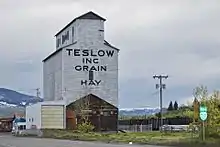
On December 21, 1882, Livingston was incorporated and named in honor of Johnston Livingston, pioneer Northern Pacific Railway stockholder, director and friend of Northern Pacific Railroad President Henry Villard. Johnston Livingston was director from 1875–1881 and 1884–1887. Crawford Livingston Jr., Johnston's nephew, is more commonly considered the town's namesake. Crawford bought the real estate after the survey and on July 17, 1883, established the First National Bank in the city. Often he spoke of Livingston as "his town," and he apparently enjoyed the publicity of supposedly having a city named for him. But the name Livingston has always stood out in the Northern Pacific official family.[5]
Livingston is along the Yellowstone River where it bends from north to east toward Billings and in proximity to Interstate 90. In July 1806 Captain William Clark of the Lewis and Clark Expedition camped on the city's present outskirts on the return trip east preparing to descend the Yellowstone River. Clark's party rejoined the Lewis party at the confluence with the Missouri River, near Williston, North Dakota.
Attractions
Although small, Livingston has a number of popular tourist attractions. The Livingston Depot, built in 1902 after two predecessors, is a restored rail station that houses a railroad museum open from May to September. The Yellowstone Gateway Museum documents regional history from one of the oldest North American archaeological sites to Wild Western and Yellowstone history. The International Fly Fishing Federation's museum is an extensive introduction to a popular game sport and hosts annual enthusiast meetings. The city was inhabited for two decades by Calamity Jane and visited by a number of traveling members of European royalty.
In 1938, Dan Bailey, an eastern fly-fisherman, established Dan Bailey's Fly Shop and mail order fly tying business on Park Street.[6] Also in Livingston is the Fly Fishing Discovery Center, a museum operated by the Federation of Fly Fishers.[7] Actors Peter Fonda and Margot Kidder, Saturday Night Live alumnus Rich Hall, musician Ron Strykert, novelist Walter Kirn, and poet Jim Harrison have lived in the city. Jimmy Buffett mentions Livingston in multiple songs.
Its economy is flat, and like the rest of the state, the unemployment rate is below the national average. Almost 50% of its workforce commutes to Bozeman, as well as the destination resort Chico Hot Springs 25 miles south, and various campsites and ranches in Paradise Valley. Recently the city has invested in attractions and accommodation for tourists visiting during the Lewis and Clark bicentennial years.
Livingston and its immediately adjacent area has 17 sites listed on the National Register of Historic Places, enumerated within Park County's NRHP listings.
It has a sister-city relationship with Naganohara, Japan.
- Images of Livingston, Montana
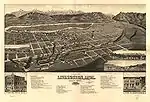 Plat of Livingston, 1883
Plat of Livingston, 1883 Gateway to Yellowstone, Frank Jay Haynes, 1884
Gateway to Yellowstone, Frank Jay Haynes, 1884 Second Livingston NPRR Depot, 1894
Second Livingston NPRR Depot, 1894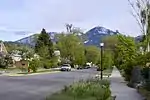 Residential neighborhood
Residential neighborhood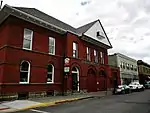 Fire station reincarnated as fitness center
Fire station reincarnated as fitness center
Geography
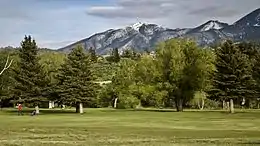
Livingston is located at 45°39′32″N 110°33′49″W (45.658840, -110.563718),[8] at an elevation of 4,501 feet (1372 m).[9]
According to the United States Census Bureau, the city has a total area of 6.03 square miles (15.62 km2), of which 6.02 square miles (15.59 km2) is land and 0.01 square miles (0.03 km2) is water.[10]
Climate
| Climate data for Livingston, Montana | |||||||||||||
|---|---|---|---|---|---|---|---|---|---|---|---|---|---|
| Month | Jan | Feb | Mar | Apr | May | Jun | Jul | Aug | Sep | Oct | Nov | Dec | Year |
| Record high °F (°C) | 67 (19) |
70 (21) |
75 (24) |
86 (30) |
93 (34) |
99 (37) |
104 (40) |
105 (41) |
99 (37) |
88 (31) |
77 (25) |
62 (17) |
105 (41) |
| Average high °F (°C) | 35 (2) |
41 (5) |
47 (8) |
55 (13) |
65 (18) |
75 (24) |
85 (29) |
85 (29) |
73 (23) |
60 (16) |
44 (7) |
36 (2) |
58 (15) |
| Average low °F (°C) | 16 (−9) |
20 (−7) |
25 (−4) |
31 (−1) |
38 (3) |
46 (8) |
50 (10) |
48 (9) |
40 (4) |
33 (1) |
24 (−4) |
18 (−8) |
32 (0) |
| Record low °F (°C) | −32 (−36) |
−33 (−36) |
−21 (−29) |
−2 (−19) |
11 (−12) |
27 (−3) |
35 (2) |
28 (−2) |
10 (−12) |
−12 (−24) |
−31 (−35) |
−41 (−41) |
−41 (−41) |
| Average precipitation inches (mm) | 0.64 (16) |
0.48 (12) |
0.85 (22) |
1.58 (40) |
2.83 (72) |
2.46 (62) |
1.54 (39) |
1.37 (35) |
1.48 (38) |
1.20 (30) |
0.74 (19) |
0.56 (14) |
15.73 (399) |
| Source: [11] | |||||||||||||
Livingston has some of the warmest winters in the state, but the temperature can feel cold because Livingston is also one of the windiest places in the United States, having the 2nd highest average wind speed among airport/AMOS stations from 2000 to 2010.[12]
Demographics
| Historical population | |||
|---|---|---|---|
| Census | Pop. | %± | |
| 1890 | 2,850 | — | |
| 1900 | 2,778 | −2.5% | |
| 1910 | 5,259 | 89.3% | |
| 1920 | 6,311 | 20.0% | |
| 1930 | 6,391 | 1.3% | |
| 1940 | 6,642 | 3.9% | |
| 1950 | 7,683 | 15.7% | |
| 1960 | 8,229 | 7.1% | |
| 1970 | 6,883 | −16.4% | |
| 1980 | 6,994 | 1.6% | |
| 1990 | 6,701 | −4.2% | |
| 2000 | 6,851 | 2.2% | |
| 2010 | 7,044 | 2.8% | |
| 2019 (est.) | 7,801 | [3] | 10.7% |
| U.S. Decennial Census[13] 2016 Estimate[14] | |||
2010 census
As of the census[2] of 2010, there were 7,044 people, 3,356 households, and 1,744 families living in the city. The population density was 1,170.1 inhabitants per square mile (451.8/km2). There were 3,779 housing units at an average density of 627.7 per square mile (242.4/km2). The racial makeup of the city was 96.2% White, 0.1% African American, 0.8% Native American, 0.3% Asian, 0.6% from other races, and 2.0% from two or more races. Hispanic or Latino of any race were 2.5% of the population.
There were 3,356 households, of which 24.7% had children under the age of 18 living with them, 39.2% were married couples living together, 9.1% had a female householder with no husband present, 3.7% had a male householder with no wife present, and 48.0% were non-families. 40.4% of all households were made up of individuals, and 14.3% had someone living alone who was 65 years of age or older. The average household size was 2.07 and the average family size was 2.81.
The median age in the city was 41.1 years. 21% of residents were under the age of 18; 5.6% were between the ages of 18 and 24; 28.3% were from 25 to 44; 28.9% were from 45 to 64; and 16.2% were 65 years of age or older. The gender makeup of the city was 48.5% male and 51.5% female.
2000 census
At the 2000 census,[15] there were 6,851 people, 3,084 households and 1,751 families living in the city. The population density was 2,601.3 per square mile (1,005.8/km2). There were 3,360 housing units at an average density of 1,275.8 per square mile (493.3/km2). The racial makeup of the city was 96.39% White, 0.31% African American, 0.98% Native American, 0.50% Asian, 0.60% from other races, and 1.23% from two or more races. Hispanic or Latino of any race were 2.16% of the population.
There were 3,084 households, of which 26.7% had children under the age of 18 living with them, 43.8% were married couples living together, 9.1% had a female householder with no husband present, and 43.2% were non-families. 37.5% of all households were made up of individuals, and 15.6% had someone living alone who was 65 years of age or older. The average household size was 2.16 and the average family size was 2.86.
Age distribution was 22.7% under the age of 18, 7.5% from 18 to 24, 27.5% from 25 to 44, 23.6% from 45 to 64, and 18.6% who were 65 years of age or older. The median age was 40 years. For every 100 females, there were 95.0 males. For every 100 females age 18 and over, there were 90.7 males.
The median household income was $28,980, and the median family income was $40,505. Males had a median income of $26,619 versus $18,684 for females. The per capita income for the city was $16,636. About 5.6% of families and 12.1% of the population were below the poverty line, including 15.0% of those under age 18 and 10.4% of those age 65 or over.
Economy
Historically a railroad city until the mid-1980s, the city today depends significantly on tourism. The Federation of Fly Fishers is based in Livingston.
Top employers
According to Livingston's 2011 Comprehensive Annual Financial Report,[16] the top private employers in Park County (the city's website refers to approximately a hundred public employees) are:
| # | Employer | # of Employees |
|---|---|---|
| 1 | Livingston HealthCare | 250–499 |
| 2 | Chico Hot Springs Resort and Day Spa | 100–249 |
| 3 | PrintingForLess | 100–249 |
| 4 | Albertsons | 50–99 |
| 5 | Best Western Mammoth Hot Springs | 50–99 |
| 6 | Church Universal and Triumphant | 50–99 |
| 7 | Community Health Partners | 50–99 |
| 8 | Livingston Health and Rehabilitation Center | 50–99 |
| 9 | Town & Country Foods | 50–99 |
| 10 | The Livingston Enterprise | 20–49 |
Education
Livingston has a public library, the Livingston-Park County Public Library.[17]
Media

Newspapers
Livingston Enterprise is a local daily newspaper, and the Livingston Current (preceded by the Park County Press and Park County Weekly) is a weekly newspaper. The monthly Montana Pioneer and bimonthly Atlantis Rising are also Livingston-based.
AM radio
- KBOZ 1090, (Talk/personality), Reier Broadcasting Company
- KOBB 1230, (Sports talk), Reier Broadcasting Company
- KPRK AM 1340, (Talk), GapWest Broadcasting
- KMMS 1450, ( News/talk), GapWest Broadcasting
FM radio
- KLEU 91.1, (Christian music/talk programming), Hi-Line Radio Fellowship
- KGLT 91.9, (Variety), Montana State University-Bozeman
- KOBB-FM 93.7, (Oldies), Reier Broadcasting Company
- KMMS-FM 94.7, (Adult album), GapWest Broadcasting
- KISN 96.7, (Top 40 (CHR)), GapWest Broadcasting
- KOZB 97.5, (Classic rock), Reier Broadcasting Company
- KBOZ-FM 99.9, (Country music), Reier Broadcasting Company
- KXLB 100.7, (Country music), GapWest Broadcasting
- KBMC (FM) 102.1, (Variety), Montana State University-Billings
- KZMY 103.5, (Hot adult contemporary), GapWest Broadcasting
- KBZM 104.7, (Classic hits), Orion Media
- KSCY 106.9, (Country music), Orion Media
Bozeman Market
Billings Market
- KULR 8 NBC, Cowles Montana Media
- KTVQ-TV 2 CBS, Evening Post Publishing Company
Filmography
The city of Livingston has been a staging area or location for a number of films, including:
- Rancho Deluxe, 1975
- Amazing Grace and Chuck, 1987
- A River Runs Through It, 1992
- The Horse Whisperer, 1998
- Cowboys vs. Dinosaurs, 2015
- Certain Women, 2016
- Walking Out, 2017
- Wildlife (film), 2018
Set in Livingston
- Yellowstone (American TV series), 2018 continuing
Notable people
- Dan Bailey, renowned fly tyer and owner of Dan Bailey's Fly Shop
- Arthur Blank, owner of Paradise Valley Pop Stand and Grill and Mountain Sky Guest Ranch[18]
- Ed Bouchee, major league baseball first baseman
- Tom Brokaw, television journalist
- Tim Cahill, travel writer
- Calamity Jane, cavalry scout, western heroine[19]
- Russell Chatham, landscape artist
- Michael Dahlquist, drummer for the band Silkworm
- Al Feldstein, comic artist and painter
- Mayhew Foster, World War II pilot who transported Hermann Göring
- Chad Franscoviak, sound engineer
- Cassidy Freeman, actress
- Eduardo Garcia, chef and businessman
- Charles Garnier Sr., Founder, Garnier Cigar Company Est. 1886, 6-term mayor of Livingston elected 1901[20][21][22][23]
- Thomas Goltz, journalist and author
- Rich Hall, comedian, writer and musician
- Jim Harrison, poet and author (Legends of the Fall)
- Torey Hayden, psychologist and author
- William Hjortsberg, author & screenwriter (Falling Angel, Legend (1985 film)
- Margot Kidder, actress
- Walter Kirn, novelist
- Thomas Leforge, mid-19th century liaison to and resident among the Crow Tribe
- Pete Lovely, race car driver
- John Mayer, musician
- Thomas McGuane, writer, novelist, film director, screenwriter
- P.W. Nelson, lawman, town marshal, first police chief of Livingston[24][25]
- Ken Niles, radio announcer and actor (Out of the Past)
- James F. O'Connor, United States Representative from Montana
- Christopher Paolini, author of the Inheritance Cycle
- Sam Peckinpah, film director; resided at the Murray Hotel from 1979–1984[26]
- Lester Thurow, economist, author and Rhodes Scholar
References
- "2019 U.S. Gazetteer Files". United States Census Bureau. Retrieved July 26, 2020.
- "U.S. Census website". United States Census Bureau. Retrieved 2012-12-18.
- "Population and Housing Unit Estimates". United States Census Bureau. May 24, 2020. Retrieved May 27, 2020.
- "Find a County". National Association of Counties. Retrieved 2011-06-07.
- Aarstad, Rich; Arguimbau, Ellie; Baumler, Ellen; Porsild, Charlene; Shovers, Brian (2009). Montana Place Names. Helena, Montana: Montana Historical Society Press. p. 157. ISBN 978-0-9759196-1-3.
- Berryman, Jack W. (2006). Fly-Fishing Pioneers and Legends of the Northwest. Seattle, WA: Northwest Fly Fishing LLC. pp. 101–107. ISBN 978-0-9779454-0-5.
- Fly Fishing Discovery Center website Archived 2008-12-31 at the Wayback Machine
- "US Gazetteer files: 2010, 2000, and 1990". United States Census Bureau. 2011-02-12. Retrieved 2011-04-23.
- "Livingston". Geographic Names Information System. United States Geological Survey.
- "US Gazetteer files 2010". United States Census Bureau. Archived from the original on 2012-07-02. Retrieved 2012-12-18.
- "Average Weather for Livingston, MT - Temperature and Precipitation". Weather.com. Retrieved August 5, 2010.
- "Climatological Extremes for Contiguous United States". Western Regional Climate Center.
- "Census of Population and Housing". Census.gov. Retrieved May 25, 2017.
- "Population Estimates". United States Census Bureau. Retrieved May 25, 2017.
- "U.S. Census website". United States Census Bureau. Retrieved 2008-01-31.
- "City of Livingston CAFR" (PDF). livingstonmontana.org. Retrieved 7 April 2018.
- "Montana Public Libraries". PublicLibraries.com. Retrieved 14 June 2019.
- "Arthur Blank's Spirit of Giving Knows No Season-Paradise Valley Pop Stand Owner and Home Depot Co-Founder Makes More to Give More". The Montana Pioneer. Archived from the original on 2010-09-24. Retrieved 2010-08-24.
- Whithorn, Doris; Bill Whithorn (1979). Calamity's In Town-The Town Was Livingston, Montana. Pray, Montana: Wan-I-Gan.
- "History Page 2".
- "Charles Garnier, Mayor of Livingston". Daily inter mountain. (Butte, Mont.) 1881-1901, April 02, 1901, Image 10. April 2, 1901. p. 10 – via chroniclingamerica.loc.gov.
- Healy, Donna. "Before World War I, Montana cigar factories boomed". The Billings Gazette.
- "United States Tobacco Journal". BMT Publications. August 10, 1921 – via Google Books.
- <http://chroniclingamerica.loc.gov/lccn/sn86075261/1900-01-01/ed-1/seq-47/>
- <http://genealogytrails.com/mon/park/bios.html>
- Cohen, Stan (2004). "The Murray Hotel". Montana's Grandest-Historic Hotels and Resorts of the Treasure State. Missoula, Montana: Pictorial Histories Publishing Company. pp. 77–80. ISBN 1-57510-111-4.
External links
| Wikimedia Commons has media related to Livingston, Montana. |
- Livingston Chamber of Commerce - Information about the Livingston area
- City of Livingston
- The Livingston Enterprise - Daily newspaper
- The Livingston Current - Weekly newspaper
- The Montana Pioneer - Monthly newspaper
- Arts Montana - Community cultural links and arts events
![]() Livingston travel guide from WikivoyageThomas McGuane
Livingston travel guide from WikivoyageThomas McGuane
